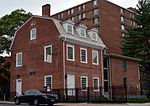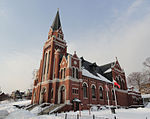Charter Oak
1850s individual tree deathsHistory of Hartford, ConnecticutIndividual oak treesIndividual trees in ConnecticutPre-statehood history of Connecticut ... and 1 more
Symbols of Connecticut

The Charter Oak was an enormous white oak tree growing on Wyllys Hyll in Hartford, Connecticut in the United States, from around the 12th or 13th century until it fell during a storm in 1856. According to tradition, Connecticut's Royal Charter of 1662 was hidden within the tree's hollow to thwart its confiscation by the English governor-general. The oak symbolized American independence and was commemorated on the Connecticut State Quarter. In 1935, Connecticut's tercentennial, it was also depicted on both a commemorative half dollar and a postage stamp.
Excerpt from the Wikipedia article Charter Oak (License: CC BY-SA 3.0, Authors, Images).Charter Oak
Charter Oak Place, Hartford Downtown Hartford
Geographical coordinates (GPS) Address Nearby Places Show on map
Geographical coordinates (GPS)
| Latitude | Longitude |
|---|---|
| N 41.7593 ° | E -72.6736 ° |
Address
Charter Oak Place 39
06106 Hartford, Downtown Hartford
Connecticut, United States
Open on Google Maps










